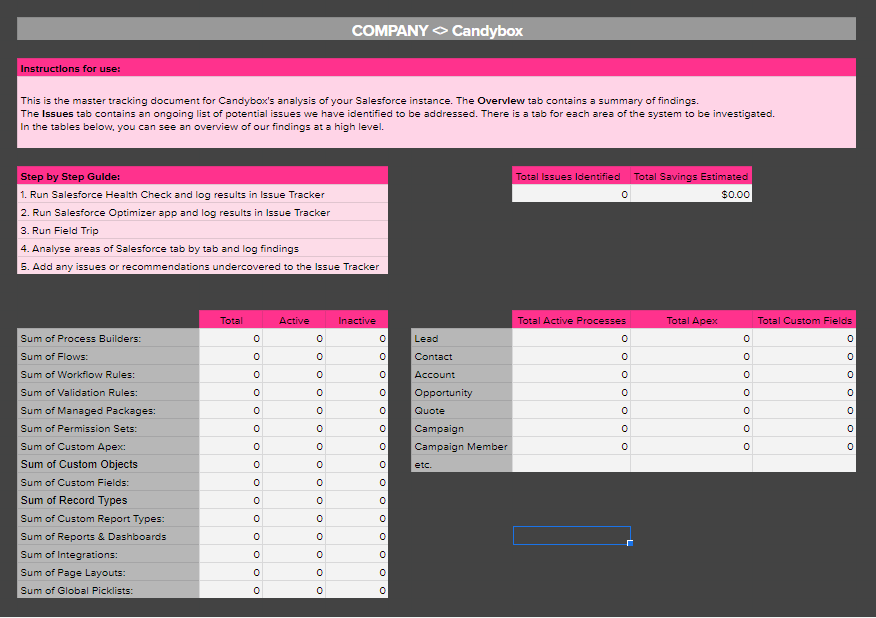We’ve written extensively about the issues of technical debt in Salesforce and how it can affect the revenue-generating arm of a business. A Salesforce instance affected by technical debt will require more resourcing both to maintain and to implement changes, and will frustrate users due to unwieldy, error-prone processes.
Technical debt is usually introduced into Salesforce due to unrealistic time constraints or insufficient resourcing. Particularly at fast-moving startups, Revenue Operations professionals are forced to deliver ‘just good enough’ solutions. Over time, this leads to a labyrinth of messy processes, overly-complex architectures, unnecessary custom apex and more.
The costs of technical debt
The costs of technical debt are very real and manifest themselves on your company’s P&L. Examples of these very real costs are:
- More headcount required simply to maintain existing systems
- Additional time required to introduce new capabilities
- Delayed delivery of new projects and technologies
- Lost sales due to outages and delays
- Less efficient sales and marketing spend
- Downstream impacts of poor data quality
This doesn’t take into account the softer costs of technical debt, which include hits to morale, productivity and agility.
Tackling technical debt
It’s clear how easy it is to generate technical debt and why your company should care about it. But how exactly do you go about tackling this issue, particularly when you’re still stretched in terms of time and resources?
This isn’t an easy problem to solve and it can be hard to know where to begin. That’s why we’ve decided to share the template we use here at Candybox to audit our customers’ technical debt and deliver a plan to address it.
You can access the spreadsheet via this link.

How to use the audit template
Our audit template contains instructions for use in the Overview tab.
Steps 1 & 2 rely on the use of Salesforce out-of-the-box tools which will give you an initial pulse on where your org is at. Step 3 is to understand the usage of fields per object, which will require downloading a free third-party app. While steps 1 to 3 are optional, we highly recommend going through them.
Steps 4 and 5 make up the bulk of the audit. Each tab in the spreadsheet refers to a specific area of Salesforce that can contribute to technical debt. Each area should be documented and then analysed to provide insight into where your Salesforce instance is healthy and where it is weighed down by technical debt. You can feel free to add or delete tabs as you see fit to adapt to your specific use cases.
Wherever you come across an issue that needs to be addressed, log it under the Issue Tracker tab along with its business impact and estimated cost or savings. These totals, along with the number of processes, custom fields, custom apex and so forth, will roll up into the Overview tab, giving you a snapshot of how your org is doing and where you can realise value.
A completed audit should contain a list of issues in the Issue Tracker. These will serve as the basis for determining how to address your technical debt. Their estimated cost to the business can be a useful way to prioritise in which order they should be tackled.
Making the most of your audit
You will get the most out of your audit if it is conducted by someone senior in your organization, like a systems architect, operations manager or consultant. The reason for this is that you need someone with both context and technical insight to determine whether or not the system is running optimally. Only then can you accurately assess the cost or savings to the business as each issue is identified.
The time the audit takes will depend on the size, age and complexity of your Salesforce org. Generally, the older your Salesforce org is and the larger it is, the more complex it will be. If you have someone technical on your team who can assist with exporting your metadata, we recommend tools such as haoide or Sonar to save you time on data collection.
To give a sense of how much time you might spend on such a project, we would estimate a minimum of 40 hours for a very high-level overview or a simple org. For a more detailed analysis or an older/more complex org, we estimate it could take up to 200 hours to complete the audit.
While this is indeed a large time investment, we have seen the savings far outweigh the time cost of the actual audit.
Interested in learning more?
One of the services Candybox offers is an audit of your Salesforce org for a fixed fee. We can help dig into the nitty-gritty of your Salesforce instance and identify the key areas where you can add value, reduce costs and mitigate technical debt. Both young and mature Salesforce orgs can benefit from a tune-up and it’s often hard to find the time internally to devote to such a project.
If you’d like to learn more, don’t hesitate to reach out to us.